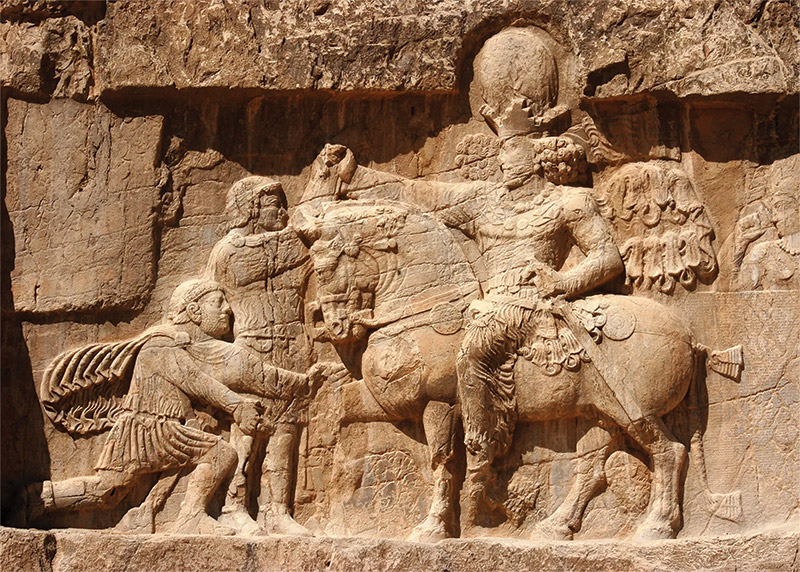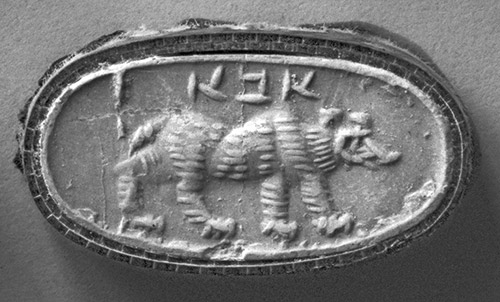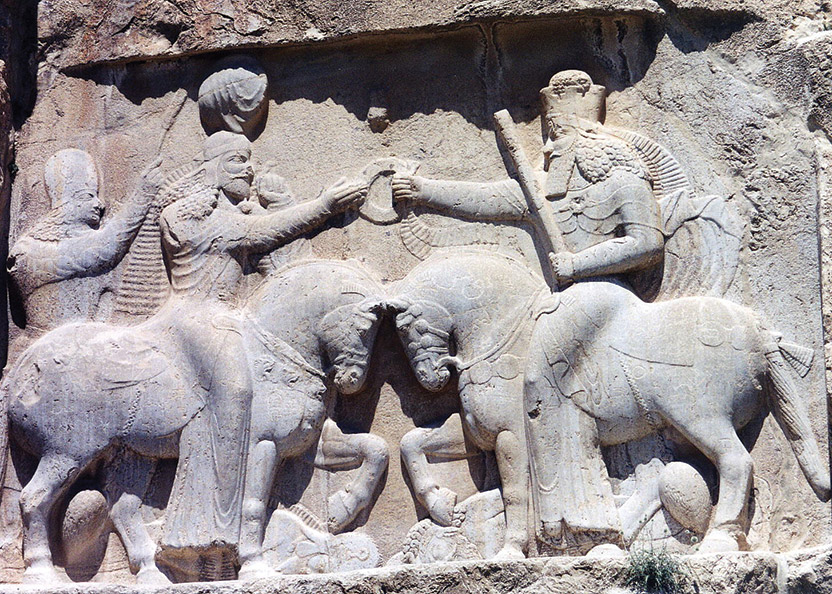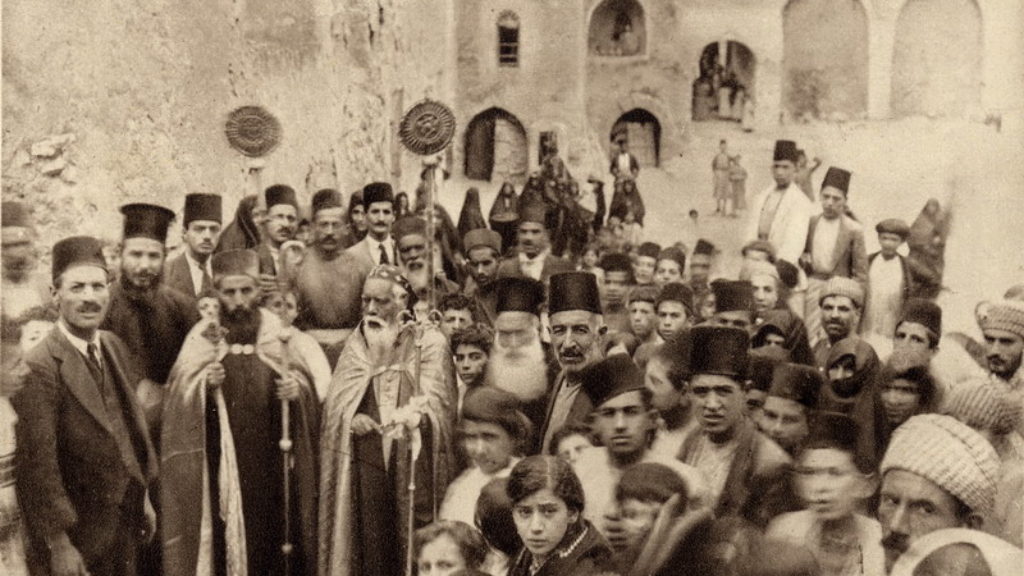Imperial Rabbis
The Babylonian Talmud is the largest and arguably the most important work on the Jewish bookshelf. Its 37 tractates and more than 2,700 folios preserve an immense body of legislation, legal analysis, and court cases, alongside a wealth of biblical interpretation, rabbinic stories and sayings, and much more. But we know surprisingly little about the people who produced the Talmud and their history. We lack basic knowledge of the relationship between Babylonian Jewry and the Persian dynasty, known as the Sasanian empire, that ruled over the region. We also do not really understand the connections between Babylonian Jewry and neighboring non-Jewish communities, nor can we begin to discern the historical turning points of the talmudic period, which lasted several hundred years from approximately 200 to 700 CE.
This is a surprising problem. The Talmud’s thousands of pages would seem to provide copious resources for charting its history, especially the hundreds of biographical stories and anecdotes about the rabbis and their interactions with others. Indeed, from the beginnings of the academic study of Jewish history in the nineteenth century until the 1970s, scholars drew on such sources to reconstruct Babylonian Jewish history. These efforts culminated in the five-volume History of the Jews of Babylonia published by the famously prolific American talmudist Jacob Neusner between 1965 and 1970.
And yet, not long after Neusner completed his massive history, he rejected its very premise. When it was republished in 1984, he wrote a new preface repudiating its method and conclusions (“There is not a page, not a paragraph, not a sentence in this book that I could write today exactly as I wrote it twenty years ago”). Neusner, along with the Israeli scholar Yonah Fraenkel, argued that rabbinic stories were often composed hundreds of years after the events they purport to describe, feature miracles and other supernatural events, contain folkloric motifs, and survive in multiple and conflicting versions. What is more, the genres of history, biography, and fiction were not understood in the same way by the ancient Jews as they are today, so rabbinic stories and anecdotes may never have been intended as reliable historical sources.They are closer to what we would call didactic fiction. In the wake of this critique, the writing of talmudic history ground to a halt, so much so that comprehensive guides to the field, such as The Cambridge Companion to the Talmud and Rabbinic Literature, and major scholarly gatherings, including a multiday Talmud conference convened at Harvard last year, hardly touch on political and social history.
Simcha Gross’s brilliant new book, Babylonian Jews and Sasanian Imperialism in Late Antiquity, is a valiant attempt to reorient the field and write the history of a period that has stubbornly defied a historical accounting. The book relates how the talmudic rabbis, and Babylonian Jewry more broadly, carved their distinctive paths in a powerful and dynamic multiethnic empire.

How does Gross get around the lack of dependable talmudic sources? For one thing, he looks beyond the Talmud to consider other materials produced by Babylonian Jews and their non-Jewish neighbors. Gross makes the most of the meager Jewish archaeological remains, such as cylinder seals adorned with Jewish and non-Jewish motifs and the so-called magic bowls—ceramic bowls inscribed with incantations, which include both Jewish and non-Jewish elements (one remarkable bowl ends by invoking “the name ‘I Am that I Am, Lord of Hosts,’ and the name of ‘Jesus who conquered the height and depth by his cross’”).
Gross also turns to Middle Persian texts, including Sasanian royal inscriptions, legal collections, and Zoroastrian theological writings to illuminate the empire’s dominant political, legal, and religious contexts. Particularly valuable is his discussion of Christian literature written in Syriac. This rich material opens a vista onto the situation of another minority religion in the Sasanian Empire, which was defined by different circumstances (such as the Christianization of the neighboring Roman Empire) but faced similar challenges as the Babylonian Jews. He also draws on recent developments in Sasanian studies that have produced richer and more nuanced understandings of the empire.
Gross also returns to the Talmud itself, but he does so armed with the new tools and results of talmudic source criticism. As it turns out, around the same period that scholars were despairing of writing conventional histories of the talmudic period, they were coming to a more sophisticated understanding of the textual history of the composition of the Talmud. Every student of the Talmud knows that the Mishnah preserves the arguments and opinions of the Tannaim, who flourished up to the early third century CE, and that the Babylonian Talmud itself preserves the work of the Amoraim, who lived from about 200 to 500 CE. What was less clear until the end of the twentieth century was how these materials were edited and by whom. These editors, the so-called “Stammaim,” lived from about 500 to 700 CE in Babylonia and were responsible for creating the work as we know it. Since talmudic source criticism reveals the Talmud to be a text that unfolded in stages, scholars like Gross can sometimes discern textual shifts that reflect historical developments.
The main argument of Babylonian Jews and Sasanian Imperialism in Late Antiquity is that talmudic sources must be understood against the background of a powerful empire that exerted a substantial influence on its inhabitants, Jews and non-Jews alike. The Sasanian kings and their agents imposed legal constraints, molded cultural contexts, and fostered social norms. Previously, scholars viewed the Babylonian Jewish community as largely independent, autonomous, and tolerated in the empire. The ruling Sasanians and the local political institutions were seen as remote, operating in the background but not really influencing Jews, who lived at some degree of social and political remove from their neighbors and overlords. Gross rejects this in favor of “a more immanent and integrationist model of Sasanian rule, which Jews could not avoid, and within and against which they positioned and defined themselves.”
The older model of a remote and largely tolerant empire emerged in part due to the relatively few references to the Sasanian court in the Talmud and the fact that when talmudic sources portray the Persian kings, they paint favorable, sympathetic pictures of them. Take this charming vignette of King Shapur kashering kitchen utensils:
Mar Yehuda and Bati bar Tovi were sitting in front of King Shapur and a citron was brought before them. [King Shapur] cut [a slice] and ate it. He cut [another slice] and gave it to Bati bar Tovi. He then stuck the knife into the ground ten times, cut [a slice], and gave it to Mar Yehuda.
Likewise, the absence of many reports about persecution, violence, and martyrdom suggested to earlier scholars that Babylonian Jewry was not oppressed. When friction did occur, it was assumed that this was the work of fanatical Zoroastrian priests rather than the fault of the Sasanian kings.

Gross is skeptical of this irenic picture, and for good reason. The Sasanian emperors ran a well-organized empire, which was home to many ethnic and religious groups. The evidence of both Zoroastrian texts and Christian literature indicates that minority communities within the empire were not left to their own devices. Although the political authorities often ruled with a degree of flexibility, they administered an elaborate bureaucracy that routinely intervened in social, cultural, and religious matters. Gross also rejects the old view that Sasanian society was rigidly hierarchical with little possibility of social mobility. Rather, Jews and rabbis, like everyone else, competed for power and status, sometimes adopting Persian ways and behaviors. In this environment, rabbis had little authority over the Jewish community, and rabbinic judicial courts could not punish religious violations. Rabbis were more like arbitrators, to whom other Jews, at times, voluntarily turned, while the Persian courts were always an option.
The rabbis’ function and status were accordingly neither determined by the traditional organization of Jewish society nor fixed by the structural conditions of the imperial powers. Rather, the sages navigated through a complex web of government officials, Zoroastrian magi, Jewish elites, and others. They were, Gross writes, “dynamic figures whose positions depended on the accrual of social prestige and cultural capital as configured within the broader social context in which they were embedded.” And they “responded to imperial domination through alternating, but not mutually exclusive, modes of accommodation, compliance, and resistance, even as they were invariably shaped by imperial rule.”
Ambitious rabbis could take advantage of opportunities to develop influence among both their fellow Jews and disparate groups of outsiders. Indeed, they sometimes were willing to bend or finesse Jewish law to avoid conflict, smooth relations with others, and advance their own interests. For instance, some rabbis used tax exemptions expressly designed for Zoroastrian officials, declaring “I am a servant of fire.” They also used halakhic distinctions to permit the sale of firewood to Zoroastrian fire temples, justifying their behavior with the excuse that “most wood is used for [ordinary] heating” rather than idolatrous purposes.
Gross has mastered difficult and disparate bodies of literature—rabbinic, Persian, Syriac, Greco-Roman, and even texts written by the then new religious movement, Manichaeism—along with the relevant scholarship (his bibliography is more than one hundred pages long). His readings of talmudic sources are sophisticated, compelling, and based on thorough engagement with manuscript variants. To fill in some gaps and shed light on obscurities, Gross has mobilized Geonic and later medieval rabbinic sources with remarkable acumen. Importantly, he is not only a consumer of scholarship in these different fields but a producer, one who charts new understandings of Sasanian politics and society from Persian, Christian, and Jewish experiences.
There are, nonetheless, serious limitations hampering Gross’s reconstruction of Babylonian Jewish history. He concedes that he can offer no chronological account of any historical events that transpired over these several centuries. Consequently, he makes no effort to determine whether conditions improved from the third to the fifth century or deteriorated or whether the Sasanian emperors of the fourth century differed from those of the previous or following century in any respect. If some persecutions and state-sponsored violence occurred, as Gross believes they did, he cannot date them or say much about the specific causes. What Gross has given us, then, is a very general sketch of the political and social history of Jews and rabbis over three or four hundred years. It is a compelling, dynamic account, different from previous approaches, yet not much more detailed. Here Gross has struck up against the limitations of his sources—there is only so much that can be known.
Perhaps as a result, Gross’s approach is noticeably “top down” in the sense that he works from an understanding of the nature and policies of the Sasanian Empire to inform his interpretation of talmudic sources. Much of the rabbinic evidence can be interpreted in different ways, and his decision to read a particular source as an accurate reflection of historical conditions, as opposed to, say, a fictional or aspirational projection of an ideal, is a function of his assumptions about the workings of the Sasanian Empire, which are largely derived from nontalmudic sources. For instance, Gross rejects the view that the Sasanian Empire was generally benevolent toward or even supported Jews and Judaism. Sasanian sources, the Syriac Christian accounts, and other evidence suggest that the Persian emperors employed state-sponsored violence when expedient, sometimes gave the Zoroastrian clergy latitude to prohibit certain Jewish and Christian practices, and occasionally persecuted them more directly. A handful of talmudic sources mention martyrdom and persecution, and there are some curious references to attacks on Jews in Christian and Persian texts. Other scholars see these references as reflections of the situation in the Land of Israel, or theoretical, or just exceptional—over the course of more than three centuries, we can expect an occasional royal persecution or some calculated violence. Gross, on the other hand, sees the few rabbinic sources mentioning Babylonian persecution as representative and significant, confirmed by the external references. He suggests that, to a large extent, the rabbis self-censored, repressing memories of persecution to create a picture of harmonious relations between Sasanian political officials and Jews.
In this respect Gross’s study remains vulnerable to the problem of attempting to draw historical conclusions from sources whose degree of historical reliability is questionable. In presenting the case for a more interventionist state apparatus that would periodically resort to violence, Gross cites the report of “the tenth-century annalist Hamza al-Isfahani,” a Muslim historian, that the Sasanian emperor Peroz (459–484) had half the Jewish population of Isfahan put to death and enslaved their children for flaying the skin of two Magian priests. Gross comments, “Without commenting on the historicity of the report, it plausibly reflects the consequences Jews or other subject communities might suffer for challenging the custodians of Zoroastrian cosmology.” But how can it reflect the consequences of anything if we don’t know the degree of historicity of the report? If al-Isfahani is mistaken, or wildly exaggerating, or inventing a report for the purposes of intimidation, his claim need not show what any community might really have suffered. And writing in the tenth century, he may not have had reliable information about a Persian emperor who lived five centuries earlier.
As further evidence for the vulnerability of Jews to state violence, Gross adduces a colorful talmudic story about a Jewish jailor who spares female prisoners from sexual assault by sprinkling wine on their garments to create the impression that they are menstruating and impure. This trickster figure dresses like a Gentile to mingle with Gentiles and eavesdrop on their conversations “so that when a harsh decree is made [against Jews], they reveal it to me and I inform the rabbis, and they pray [to God] and the decree is annulled” (Taanit 22a). Gross comments that “this story clearly presupposes that edicts against Jews were regular occurrences requiring ongoing subterfuge on the part of the jailer.” That may be true, but it is again part of the narrative world of the story, whose connection to actual Sasanian edicts is questionable. Even if we take the story as evidence of real edicts, it is a leap to conclude that such edicts characterize royal policy, as opposed to, say, the acts of an oppressive local governor. The folkloric elements in the story, including the trickster, the cross-dressing, Elijah the Prophet, and effective prayer—all of which Gross acknowledges—complicate using the story for historical purposes, even Gross’s minimalist ones.

Gross does discuss the rabbinic traditions that depict the Sasanians and the kings in a more favorable light but tends to dismiss them:
The Babylonian Talmud’s portrayal of an unfailingly neutral king, never even appearing with magi in the same story, offers a similar idyll of an Empire with which rabbis and Jews could negotiate, one in which religious interference was an aberration rather than a fundamental feature.
I tend to accept Gross’s argument, but it is difficult to know when to read a rabbinic story as idyllic or as an aberrant outlier, rather than as reflecting, to some degree, historical reality.
Gross is a careful and self-conscious scholar who is aware of these and other difficulties and always makes a careful and judicious case. I believe he is generally correct in his interpretations of the rabbinic evidence and therefore of his claims concerning the relationship between Jews and the Sasanian Empire, the role and function of rabbis, and the nature of the Jewish community. But given that many of his sources, both Jewish and non-Jewish, can be read in radically different ways, the history of Babylonian Jewry remains open, if no longer entirely uncharted, territory.
Comments
You must log in to comment Log In
Suggested Reading

No Balm
A new book on talmudic medicine illustrates the ills of modern academia, argues Shai Secunda.

Where Abraham Walked
Preserved for centuries by Syrian Christians, spoken-Aramaic is now breathing its last.

Persian Daughters of Israel
Leah Sarna imagines Jewish and Gentile women doing their laundry on the banks of the Tigris, sharing tricks for keeping their headscarves tied and their bedrooms pure. She reviews Shai Secunda’s new book on just how Babylonian the Babylonian Talmud was.

Common Clay
Virtually nothing of Babylonian Jewry of the talmudic period, from the 3rd to the 6th century C.E., has survived beyond the Babylonian Talmud itself to help contextualize or confirm the many things the text tells its readers.
JJ Gross
This is the first I am hearing about Simcha Gross's magnum opus. However I am astonished that Jeffrey Rubenstein makes no mention of an earlier work by Hebrew University Professor Yeshayahu Gafni; Yehudei Bavel B'Tkufat HaTalmud -- The Jews of Babylonia in the Talmudic Era, A Social and Cultural History (The Zalman Shazar Center, 1990). For me, however, the key question is did Babylonian Jewry create rabbinic Judaism or did rabbinic Judaism create Babylonian Jewry, i.e. rabbis who preferred the material comfort of a diaspora lifestyle thereby inventing a new exegetical Judaism which would make diaspora Jewish life both viable and subject to their control. The question is not academic. Indeed, if Talmud is an invention of/for the diaspora then we must reconsider the very applicability and relevance of rabbinic Judaism now that at least some of us are once again living in a Jewish state. As well, it is worth mentioning that Talmudic sages, like so many rabbis over the centuries and certainly today, could at times be rather self-serving. They would have cozy relations with the authorities, act as tax collectors, render themselves exempt from taxation, and get first dibs on properties that were forfeited from Jews who had defaulted on their tax payments. No doubt most were at least reasonably honest, but greed and wheeling-dealing were hardly unknown, and has become by now a commonplace.